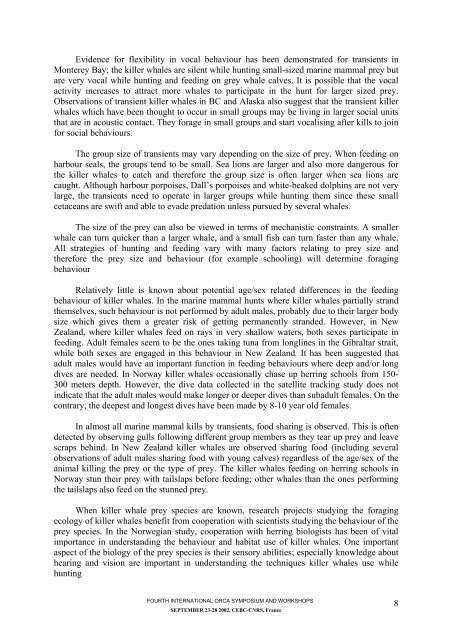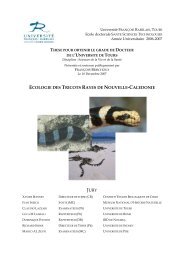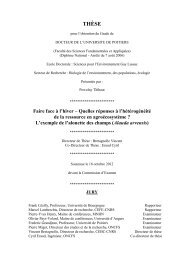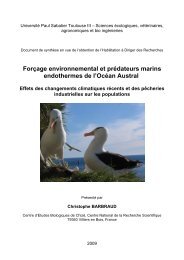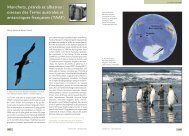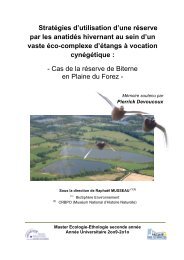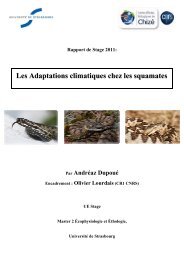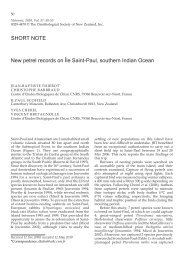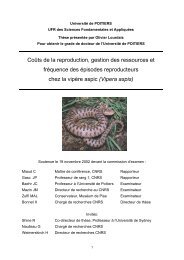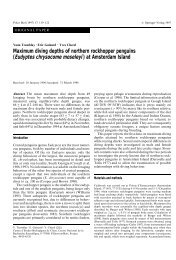Fourth International Orca Symposium and Workshop - CEBC - CNRS
Fourth International Orca Symposium and Workshop - CEBC - CNRS
Fourth International Orca Symposium and Workshop - CEBC - CNRS
Create successful ePaper yourself
Turn your PDF publications into a flip-book with our unique Google optimized e-Paper software.
Evidence for flexibility in vocal behaviour has been demonstrated for transients in<br />
Monterey Bay; the killer whales are silent while hunting small-sized marine mammal prey but<br />
are very vocal while hunting <strong>and</strong> feeding on grey whale calves. It is possible that the vocal<br />
activity increases to attract more whales to participate in the hunt for larger sized prey.<br />
Observations of transient killer whales in BC <strong>and</strong> Alaska also suggest that the transient killer<br />
whales which have been thought to occur in small groups may be living in larger social units<br />
that are in acoustic contact. They forage in small groups <strong>and</strong> start vocalising after kills to join<br />
for social behaviours.<br />
The group size of transients may vary depending on the size of prey. When feeding on<br />
harbour seals, the groups tend to be small. Sea lions are larger <strong>and</strong> also more dangerous for<br />
the killer whales to catch <strong>and</strong> therefore the group size is often larger when sea lions are<br />
caught. Although harbour porpoises, Dall’s porpoises <strong>and</strong> white-beaked dolphins are not very<br />
large, the transients need to operate in larger groups while hunting them since these small<br />
cetaceans are swift <strong>and</strong> able to evade predation unless pursued by several whales.<br />
The size of the prey can also be viewed in terms of mechanistic constraints. A smaller<br />
whale can turn quicker than a larger whale, <strong>and</strong> a small fish can turn faster than any whale.<br />
All strategies of hunting <strong>and</strong> feeding vary with many factors relating to prey size <strong>and</strong><br />
therefore the prey size <strong>and</strong> behaviour (for example schooling) will determine foraging<br />
behaviour<br />
Relatively little is known about potential age/sex related differences in the feeding<br />
behaviour of killer whales. In the marine mammal hunts where killer whales partially str<strong>and</strong><br />
themselves, such behaviour is not performed by adult males, probably due to their larger body<br />
size which gives them a greater risk of getting permanently str<strong>and</strong>ed. However, in New<br />
Zeal<strong>and</strong>, where killer whales feed on rays in very shallow waters, both sexes participate in<br />
feeding. Adult females seem to be the ones taking tuna from longlines in the Gibraltar strait,<br />
while both sexes are engaged in this behaviour in New Zeal<strong>and</strong>. It has been suggested that<br />
adult males would have an important function in feeding behaviours where deep <strong>and</strong>/or long<br />
dives are needed. In Norway killer whales occasionally chase up herring schools from 150-<br />
300 meters depth. However, the dive data collected in the satellite tracking study does not<br />
indicate that the adult males would make longer or deeper dives than subadult females. On the<br />
contrary, the deepest <strong>and</strong> longest dives have been made by 8-10 year old females.<br />
In almost all marine mammal kills by transients, food sharing is observed. This is often<br />
detected by observing gulls following different group members as they tear up prey <strong>and</strong> leave<br />
scraps behind. In New Zeal<strong>and</strong> killer whales are observed sharing food (including several<br />
observations of adult males sharing food with young calves) regardless of the age/sex of the<br />
animal killing the prey or the type of prey. The killer whales feeding on herring schools in<br />
Norway stun their prey with tailslaps before feeding; other whales than the ones performing<br />
the tailslaps also feed on the stunned prey.<br />
When killer whale prey species are known, research projects studying the foraging<br />
ecology of killer whales benefit from cooperation with scientists studying the behaviour of the<br />
prey species. In the Norwegian study, cooperation with herring biologists has been of vital<br />
importance in underst<strong>and</strong>ing the behaviour <strong>and</strong> habitat use of killer whales. One important<br />
aspect of the biology of the prey species is their sensory abilities; especially knowledge about<br />
hearing <strong>and</strong> vision are important in underst<strong>and</strong>ing the techniques killer whales use while<br />
hunting<br />
FOURTH INTERNATIONAL ORCA SYMPOSIUM AND WORKSHOPS<br />
SEPTEMBER 23-28 2002, <strong>CEBC</strong>-<strong>CNRS</strong>, France<br />
8


